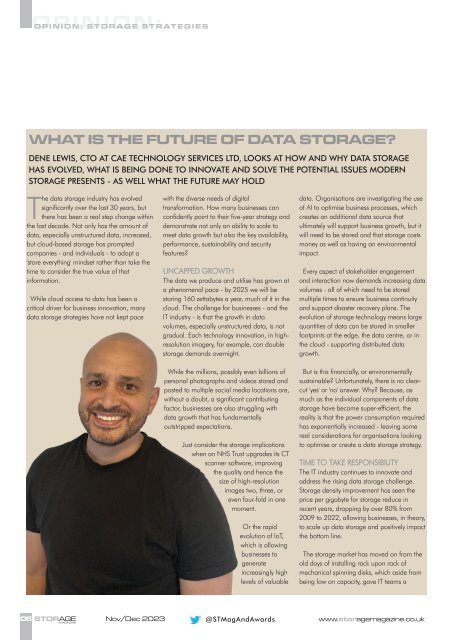ST Nov-Dec 2023
You also want an ePaper? Increase the reach of your titles
YUMPU automatically turns print PDFs into web optimized ePapers that Google loves.
CAE 6.qxd 01-<strong>Dec</strong>-23 10:53 AM Page 2<br />
OPINION:<br />
OPINION: <strong>ST</strong>ORAGE <strong>ST</strong>RATEGIES<br />
WHAT IS THE FUTURE OF DATA <strong>ST</strong>ORAGE?<br />
DENE LEWIS, CTO AT CAE TECHNOLOGY SERVICES LTD, LOOKS AT HOW AND WHY DATA <strong>ST</strong>ORAGE<br />
HAS EVOLVED, WHAT IS BEING DONE TO INNOVATE AND SOLVE THE POTENTIAL ISSUES MODERN<br />
<strong>ST</strong>ORAGE PRESENTS - AS WELL WHAT THE FUTURE MAY HOLD<br />
af<br />
The data storage industry has evolved<br />
significantly over the last 30 years, but<br />
there has been a real step change within<br />
the last decade. Not only has the amount of<br />
data, especially unstructured data, increased,<br />
but cloud-based storage has prompted<br />
companies - and individuals - to adopt a<br />
'store everything' mindset rather than take the<br />
time to consider the true value of that<br />
information.<br />
While cloud access to data has been a<br />
critical driver for business innovation, many<br />
data storage strategies have not kept pace<br />
with the diverse needs of digital<br />
transformation. How many businesses can<br />
confidently point to their five-year strategy and<br />
demonstrate not only an ability to scale to<br />
meet data growth but also the key availability,<br />
performance, sustainability and security<br />
features?<br />
UNCAPPED GROWTH<br />
The data we produce and utilise has grown at<br />
a phenomenal pace - by 2025 we will be<br />
storing 160 zettabytes a year, much of it in the<br />
cloud. The challenge for businesses - and the<br />
IT industry - is that the growth in data<br />
volumes, especially unstructured data, is not<br />
gradual. Each technology innovation, in highresolution<br />
imagery, for example, can double<br />
storage demands overnight.<br />
data. Organisations are investigating the use<br />
of AI to optimise business processes, which<br />
creates an additional data source that<br />
ultimately will support business growth, but it<br />
will need to be stored and that storage costs<br />
money as well as having an environmental<br />
impact.<br />
Every aspect of stakeholder engagement<br />
and interaction now demands increasing data<br />
volumes - all of which need to be stored<br />
multiple times to ensure business continuity<br />
and support disaster recovery plans. The<br />
evolution of storage technology means large<br />
quantities of data can be stored in smaller<br />
footprints at the edge, the data centre, or in<br />
the cloud - supporting distributed data<br />
growth.<br />
While the millions, possibly even billions of<br />
personal photographs and videos stored and<br />
posted to multiple social media locations are,<br />
without a doubt, a significant contributing<br />
factor, businesses are also struggling with<br />
data growth that has fundamentally<br />
outstripped expectations.<br />
Just consider the storage implications<br />
when an NHS Trust upgrades its CT<br />
scanner software, improving<br />
the quality and hence the<br />
size of high-resolution<br />
images two, three, or<br />
even four-fold in one<br />
moment.<br />
Or the rapid<br />
evolution of IoT,<br />
which is allowing<br />
businesses to<br />
generate<br />
increasingly high<br />
levels of valuable<br />
But is this financially, or environmentally<br />
sustainable? Unfortunately, there is no clearcut<br />
'yes' or 'no' answer. Why? Because, as<br />
much as the individual components of data<br />
storage have become super-efficient, the<br />
reality is that the power consumption required<br />
has exponentially increased - leaving some<br />
real considerations for organisations looking<br />
to optimise or create a data storage strategy.<br />
TIME TO TAKE RESPONSIBILITY<br />
The IT industry continues to innovate and<br />
address the rising data storage challenge.<br />
Storage density improvement has seen the<br />
price per gigabyte for storage reduce in<br />
recent years, dropping by over 80% from<br />
2009 to 2022, allowing businesses, in theory,<br />
to scale up data storage and positively impact<br />
the bottom line.<br />
The storage market has moved on from the<br />
old days of installing rack upon rack of<br />
mechanical spinning disks, which aside from<br />
being low on capacity, gave IT teams a<br />
06 <strong>ST</strong>ORAGE <strong>Nov</strong>/<strong>Dec</strong> <strong>2023</strong><br />
@<strong>ST</strong>MagAndAwards<br />
www.storagemagazine.co.uk<br />
MAGAZINE

















